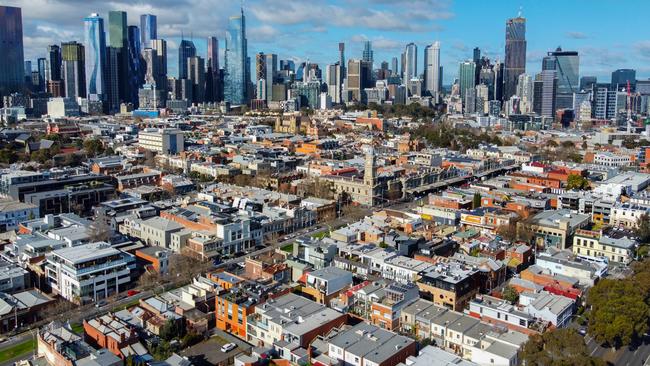Why Melbourne property won’t be in the bargain basement for very long
High taxes are pushing investors out of Victoria but strong population growth in that state means those in it for the long term will ultimately be rewarded.

Property investors are fleeing Victoria thanks to high taxes and escalating regulation pushing the state to the bottom of the ladder.
But when you look at the numbers, the argument for growth is much stronger than the actual cost of the state government’s recent tax increases, which some refer to as “tax gouging”.
Disenchantment with the government will only destabilise prices for so long. Eventually, true market factors will prevail and investors will realise they have bought Victorian property as cheaply as they ever might.
When a market sags, as it currently is due to sentiment and not facts and figures, investors have an opportunity to snap up a bargain. The reality for property investors is that there are clear fundamentals, such as population growth and a shortage of supply which make investing in Victoria a compelling long-term opportunity outweighing the current reported costs related to taxes and interest rates.
Let’s look at the problem that’s causing so much concern. To raise an additional $1bn, the Parliamentary Budget Office announced that about 860,000 Victorians will pay more land tax.
According to the Real Estate Institute of Victoria, the average price for dwellings in Victoria is between $571,402 regionally and $780,000 in the city. If we take the higher number of $780,000, the new land tax – according to the state revenue calculator – will be $3330.
In 2023, it would have been $1875. This makes the additional cost to investors $1455 (which is all tax deductible, by the way).
According to data by the Organisation for Economic Co-operation and Development (OECD) released earlier this year, the average tax rate of Australians is 24.9 per cent, meaning the net additional cost to an average taxpayer would be closer to $1100. Note that the numbers released by the Parliamentary Budget Office argue that almost half of the people affected will only be charged an additional $878 per year.
If the same average-priced Victorian property achieves capital growth over the next 10 years of just 6 per cent (below the national dwelling increase average according to CoreLogic), it will be valued at about $1.4m in 10 years. That is a gain of $62,000 per year. The sting is that this additional tax is to recoup the costs associated with the Victorian government’s handling of Covid-19. Many Victorians feel that they are paying for someone else’s mismanagement and, as a result, it is a much more bitter pill to swallow.
It’s understandable to feel frustrated about this situation, but it’s important to look at the bigger picture and the long-term investment potential that Victoria offers.
Railing against the government will not stop property prices from increasing if the fundamentals are still creating pressure on the market.
Let’s consider the fundamentals that affect property price growth. Supply and demand are largely fuelled by population growth. Where you have strong growth in population, you have demand for housing.
Victoria is growing in greater numbers than any other state, according to the ABS and state government. It is still on target to overtake NSW as the largest city by population and will clock a whopping 10.3 million by 2051 (that’s around 4 million extra people).
There are two types of population growth: internal and external (international) migration. Victoria and NSW experience the strongest international immigration, but these numbers are reduced by some internal departures.
As of December 2023, NSW has a net loss of 31,670 people moving to other states, Victoria experienced a loss of just 272, while Queensland received an additional 31,595 arrivals from interstate.
When international borders were closed, states like Queensland experienced the strongest population growth. However, since borders have opened up, Victoria has reclaimed its position as the fastest-growing state. From September 2022 to September 2023, Victoria experienced 193,000 net growth, followed by NSW at 186,000 (ABS), Queensland 144,000 and Perth at 99,000.
If we consider the overall effect on house supply and demand, according to the Victorian government (vic.gov.au) the state will need 2.24 million homes by 2051, or 80,000 to 90,000 per annum to accommodate this growth.
But according to ABS figures, we are building about 50,000 per year currently, and we haven’t built more than around 70,000 per year ever historically. By comparison, according to the Queensland government that state requires an additional 45,000 homes per year to accommodate population growth and is currently building about 35,000 per year (Homes for Queenslanders Master Builders Queensland).
The gap in Melbourne is extraordinary compared with these numbers and yet the Victorian market has been very flat.
If the fundamentals prevail and housing prices continue to be affected by supply and demand, then it seems Melbourne has some catching up to do.
The reality is that the disincentive to invest is being overstated and won’t last indefinitely. Victoria currently represents an opportunity to buy at a great price compared with other states that do not have the same growth trajectory, and it won’t last.
Anissa Cavallo is an adviser with Eda Property.




To join the conversation, please log in. Don't have an account? Register
Join the conversation, you are commenting as Logout